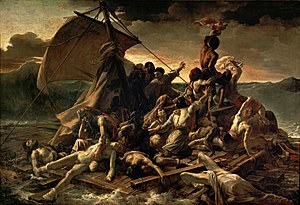
The Salon of 1819 was an art exhibition held at the Louvre in Paris between 25 August and 30 September 1819. It was the largest Salon to be staged since the fall of Napoleon.[1] It took place during the Restoration era with Louis XVIII on the throne. It was the first to be held since the withdrawal of Allied Occupation forces from the country at the end of the previous year. The two officials behind the exhibition the Count Forbin and Vicomte de Senonnes set out to make it even more a celebration of the House of Bourbon that the previous Salon of 1817.[2]
More than thirteen hundred paintings were displayed at the Salon.[3] Over a hundred paintings were in the then fashionable Troubadour style including Roger Freeing Angelica by Jean-Auguste-Dominique Ingres.[4] Alexander the Great Visiting Apelles by Marie Nicolas Ponce-Camus was rejected from submission as the jury believed it alluded to a visit Napoleon had made to the studio of Jacques-Louis David during the Hundred Days. By contrast Horace Vernet's Massacre of the Mamelukes, taken to be a covert reference to the White Terror against Napoleon's supporters, was allowed to be displayed.[5] Vernet exhibited a number of works at the Salon including The Dog of the Regiment Wounded.
Louis Hersent produced a popular history painting Gustave Vasa.[6] Amongst others who exhibited was the rising star Ary Scheffer.[7] The standout work was The Raft of the Medusa by Théodore Géricault depicting the shipwreck of the frigate Medusa.[8]
